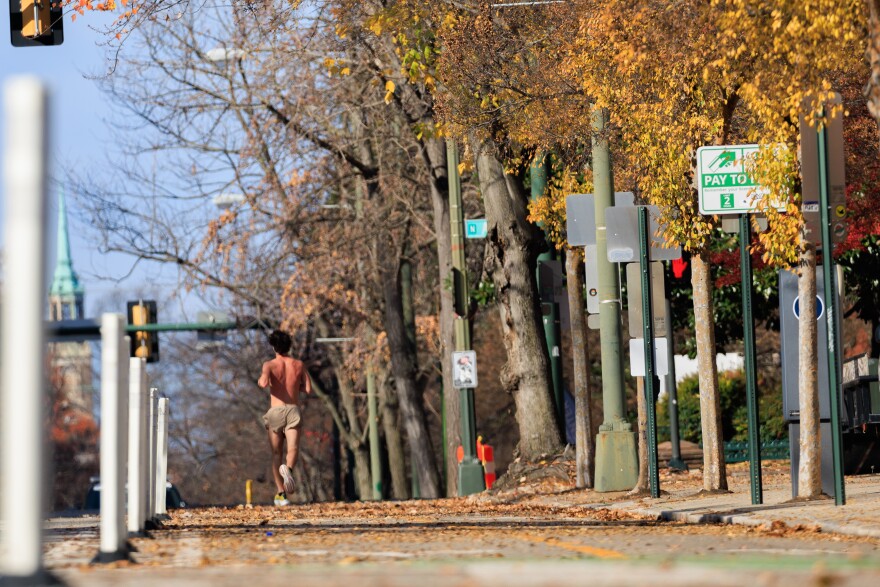Dubbed “lighter, quicker, cheaper,” the Richmond Connects projects are part of an in-depth list of proposed infrastructure to help make the city’s transportation more equitable.
“While transportation planning and projects can be a long time, these really proved to be good solutions for right now,” said Dironna Moore-Clarke, one of the administrators. “One of the key pillars of the action plan was to really give a directive of how we can do things effectively and efficiently.”
Moore-Clarke heads RVA Connects, Office of Equitable Transit and Mobility, under the Department of Public Works. RVA Connects states that past transportation decisions – such as when the U.S. government built Interstate 95 through Jackson Ward and other majority-Black neighborhoods– have created injustices that have harmed people of color, low-income communities that still exist today.
The list includes suggestions for temporary roundabouts that can be created with blinking signage and paint; solid planters or bike racks in parking spaces to make it more visible for drivers to see pedestrians; and protected bike lanes aligned with planters or flex posts.
“Temporary roundabouts can be as simple as planters for a one-hour pop up to study traffic patterns and driver behavior or pedestrian behavior,” said Lucy Bolin, an intern at RVA Connects. “Or they could even be as long-term as flex posts and murals. Like more permanent materials, but still not as expensive as pouring concrete and doing landscaping.”
Other projects would make sidewalks more compliant with federal accessibility guidelines by adding rubber mats to connect sidewalks to bus stops. All would be put in place to study and get community feedback until permanent infrastructure could be built.
Bolin said she checked out a lot of different cities who adopted programs such as “Lighter, Quicker, Cheaper” and said some call their temporary infrastructure improvements “Tactical Urbanism” or “Quick Builds.”
In cities Bolin studied and reached out to — like Atlanta; Fayetteville, Arkansas; or Orlando, Florida — they use specific metrics to determine if a temporary project should become permanent.
“For example, a crosswalk improvement gives a list including things like how many people are using it, what is the driver behavior, are speeds reduced, things like that,” she said.

These quick fixes can be great for when there’s an uptick in traffic fatalities, such as when two Virginia Commonwealth University students were fatally struck and killed by drivers earlier in 2023. Both the city and school quickly installed no right turn on red signs, added speed bumps along some high-volume campus streets and later, started the process to give pedestrians a head start before right-turning cars.
“Typically, when there's a safety issue, we have been solving this either by a study or some long-term solution,” said Moore-Clarke. “With the action plan, we really wanted to identify projects that could be addressed right away based on what the citizens have said.”
The list came from two years of citizen input, with more than 8,000 initial comments on the draft.
Money for the temporary projects — just under $500,000 — is in the budget, Moore-Clarke said. Once approved to move forward, her office would seek funds from state or federal sources.
“It's affordable. We budgeted for it in this budget, because we want it to really hit the ground running,” said Moore-Clarke. “I think that is going to give a lot of momentum for Richmond Connects and its strategies to really get to an equitable and safe transportation network.”
Some of the other temporary installations involve projects like curb extensions, said project administrator Kelli Rowan.
“Instead of pouring concrete it could be flex posts and paint,” she said. “It could also include things like a bike corral or maybe there's a parking space at the end of a block that we want to not have cars parked there to increase our visibility at the intersection and get some other use out of it like bike parking.”
Rowan said she really wants the community involved in the process – something that RVA Connects has been doing from the start.
“We envision these being highly visible projects,” said Rowan. “Things that are community oriented and community led, like for the artwork.”
She said neighborhood groups or organizations can take ownership of an intersection and help design what it could look like.
“We would love to see residents coming to us with the ideas and as long as they align with Richmond Connects,” said Rowan.
The plan still has to be approved by city officials.
The public can leave comments at RVA Connects through Tuesday, Dec. 5.



